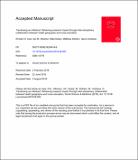Files in this item
Transfusing our lifeblood: reframing research impact through inter-disciplinary collaboration between health geography and nurse education
Item metadata
| dc.contributor.author | Kyle, Richard G. | |
| dc.contributor.author | Atherton, Iain M. | |
| dc.contributor.author | Kesby, Mike | |
| dc.contributor.author | Sothern, Matthew | |
| dc.contributor.author | Andrews, Gavin | |
| dc.date.accessioned | 2018-08-02T23:34:05Z | |
| dc.date.available | 2018-08-02T23:34:05Z | |
| dc.date.issued | 2016-11 | |
| dc.identifier | 244760901 | |
| dc.identifier | 20b6338d-56c6-417e-b862-5c0dd7e09e06 | |
| dc.identifier | 84991660146 | |
| dc.identifier | 000386186900031 | |
| dc.identifier.citation | Kyle , R G , Atherton , I M , Kesby , M , Sothern , M & Andrews , G 2016 , ' Transfusing our lifeblood: reframing research impact through inter-disciplinary collaboration between health geography and nurse education ' , Social Science and Medicine , vol. 168 , pp. 257-264 . https://doi.org/10.1016/j.socscimed.2016.08.002 | en |
| dc.identifier.issn | 0277-9536 | |
| dc.identifier.other | RIS: urn:7A9234FE5D7E2BCBCEAA7C852844DA52 | |
| dc.identifier.other | ORCID: /0000-0001-7789-870X/work/60195443 | |
| dc.identifier.uri | https://hdl.handle.net/10023/15753 | |
| dc.description | The authors wish to thank the Economic and Social Research Council (ESRC) for funding this seminar series (Grant Number: ES/L000741/1). | en |
| dc.description.abstract | Geographers have long grappled with how their research can positively impact individuals, communities and society. Demonstrating research impact is an increasingly important aspect of academic life internationally. In this paper we argue that agendas for encouraging ‘impact’ would be well-served if impact through teaching was identified and stimulated more explicitly, and if academics better recognised and seized the opportunities that already exist for such impact. We take engagement between health geography and nurse education as an example of how social scientists could demonstrate research impact through inter-disciplinary involvement in the education of health care professionals, and specifically student nurses. We begin by showing how the UK's Research Excellence Framework (widely regarded as the key reference point for research performance management regimes internationally) has tended to produce an undervaluation of impact via education in many disciplines. A comprehensive overview of international scholarship at the intersection between geography and nursing is then presented. Here we trace three ‘waves of enquiry’ that have focused on research interactions before calling for a fourth focused on critical pedagogy. To illustrate the possibilities of this fourth wave, we sketch a case study that outlines how engagement with research around blood donation could help provide a foundation for critical pedagogy that challenges student nurses to practice reflexively, think geographically and act justly. Finally, we call for closer engagement between health geography and nurse education, by encouraging educators to translate, teach, and transfuse ideas and people between health geography and nurse education. In so doing, we argue that work at this interface can be mutually beneficial and demonstrate impact both within and beyond research assessment rubrics. Hence, our ideas are relevant beyond nurse education and geography insofar as this paper serves as an example of how reframing research impact can recover the importance of impact through education. | |
| dc.format.extent | 8 | |
| dc.format.extent | 836572 | |
| dc.language.iso | eng | |
| dc.relation.ispartof | Social Science and Medicine | en |
| dc.subject | Research impact | en |
| dc.subject | Research assessment | en |
| dc.subject | Geography | en |
| dc.subject | Nursing | en |
| dc.subject | Interdisciplinary | en |
| dc.subject | Students | en |
| dc.subject | Pedagogy | en |
| dc.subject | G Geography (General) | en |
| dc.subject | RT Nursing | en |
| dc.subject | NDAS | en |
| dc.subject.lcc | G1 | en |
| dc.subject.lcc | RT | en |
| dc.title | Transfusing our lifeblood: reframing research impact through inter-disciplinary collaboration between health geography and nurse education | en |
| dc.type | Journal article | en |
| dc.contributor.institution | University of St Andrews. School of Geography and Geosciences | en |
| dc.contributor.institution | University of St Andrews. Geography & Sustainable Development | en |
| dc.identifier.doi | https://doi.org/10.1016/j.socscimed.2016.08.002 | |
| dc.description.status | Peer reviewed | en |
| dc.date.embargoedUntil | 2018-08-03 |
This item appears in the following Collection(s)
Items in the St Andrews Research Repository are protected by copyright, with all rights reserved, unless otherwise indicated.

